Birders often have to travel to the more obscure corners of Britain to see our scarcer breeding birds. However, one of these sparsely distributed species does not necessarily require such endeavours, particularly if you live in southern England: Black Redstart.
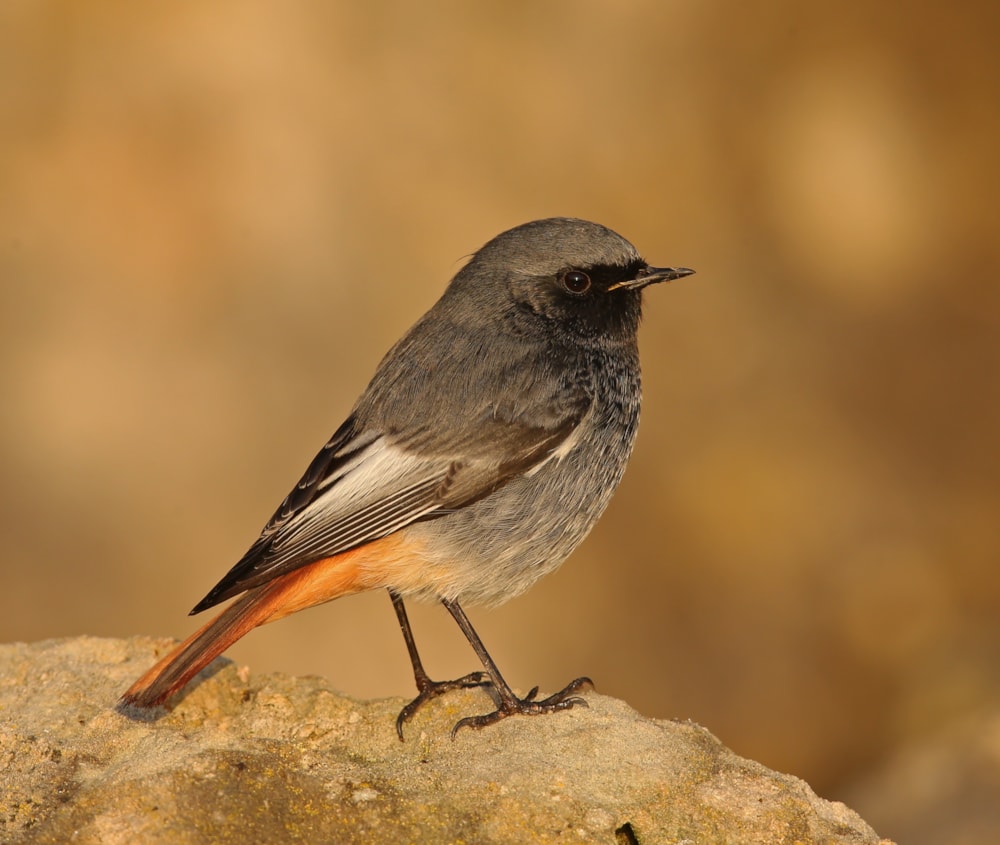
Black Redstart is one of our rarest and most beautiful breeding passerines (Mark Chivers).
First recorded as breeding in Britain at the Wembley Exhibition Centre, London, in 1926, the species needed the destruction of the World War II and its aftermath to properly put down roots. Now, despite its Red-listed status, Black Redstart can be seen in the very heart of some of our cities, often singing and nesting right next to passing traffic and bustling humans.
Black Redstart is a fairly small chat, which in turn is a flycatcher of the family Muscicapidae, rather than a thrush as was traditionally thought. It has a mostly dark body and orange-red tail and hind quarters, with a dark band down the centre. In the field, the sometimes habitual 'shivering' of its orange tail can be what first grabs the attention out of the corner of your eye, as it lands.
Adult male Phoenicurus ochruros gibraltariensis – the subspecies found in western Europe – is a strikingly beautiful charcoal grey, with a deeper black face and breast, a pure white panel in the wing and a white vent area, with dark grey unfeathered areas. Advanced first-summer males are similar, but tend to have worn brown wings. Females, immatures and early first-summer males are a dirty grey-brown all over, apart from darker centres to the wing feathers, with less white on the ventral area and the tell-tale tail. Some first-winter males have black plumage like adults and are known as 'paradoxus', while those with grey plumage are termed 'cairii'; both have brown wings and will sing in early spring like adult males. Typical male Black Redstarts are easily told from Common by the absence of orange underparts and white forehead.
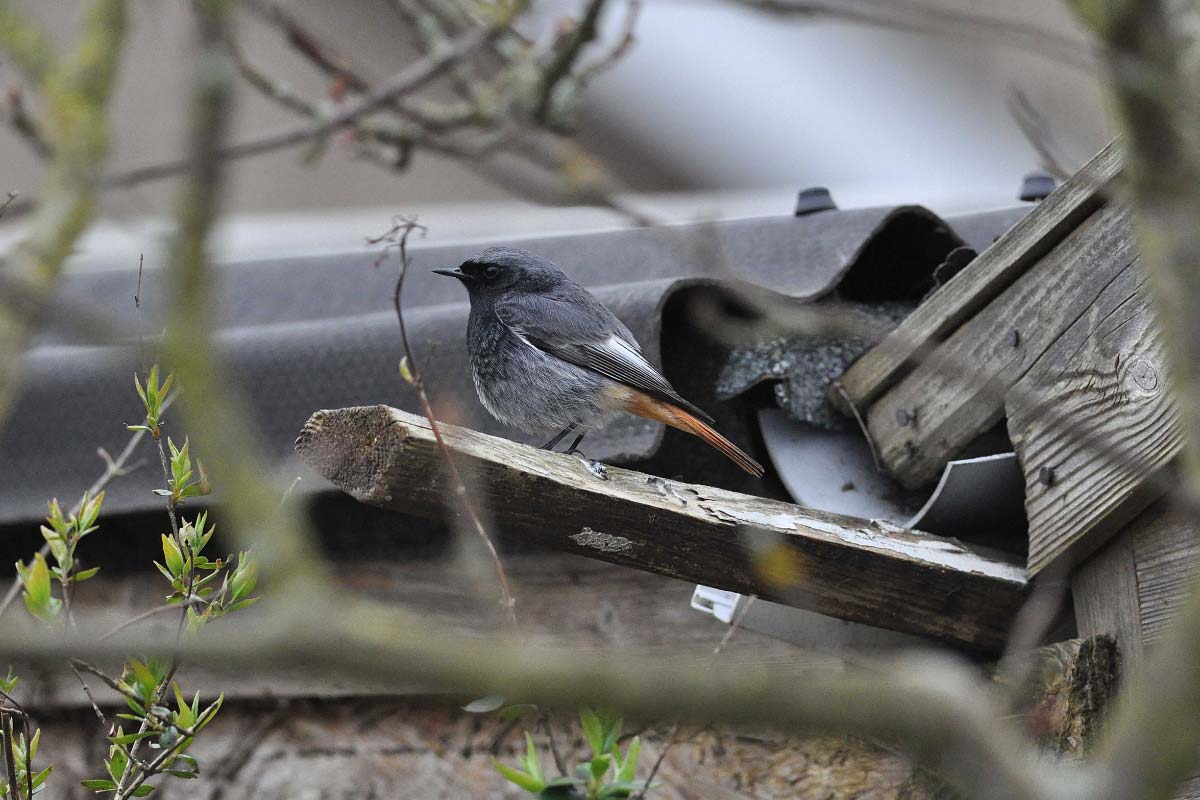
Black Redstart appears to have adapted well to living among humans, being seen in towns and villages in settings such as construction sites, factories, industrial units and gardens. For such striking birds, males are able to blend in very easily (Moss Taylor).
City living
In Britain, this robin-sized bird is a denizen of power stations, industrial sites and buildings with sparsely weedy and stony areas for foraging. Early risers can sometimes hear its atmospheric scratchy song echoing around the buildings of Manchester, Liverpool and London, as well as the towers of Dungeness Nuclear Power Station, Kent, and Sizewell B Nuclear Power Station, Suffolk – a sound reminiscent of glass being ground.
In its core range in Europe, Black Redstart is a montane species which has adapted to villages, cities and towns. Its song is a common background sound from North Africa to southern Sweden and from France to Georgia. European birds winter almost as far south as the Horn of Africa, and it is both an altitudinal and short- and long-distance migrant, particularly the farther east one gets.
It prefers rock and scree habitats, but generally avoids wetter areas and dense vegetation unless there are buildings nearby. In Britain, on passage and in winter, I've seen it almost everywhere, including seawalls on the River Thames, high streets and secluded Exmoor bays in north Devon, toilet blocks next to reedbeds at Rainham Marshes RSPB and snowed-under canal towpaths in east London, but its favoured locations are almost always near adjacent buildings and unvegetated areas.

Black Redstart made good use of bombsites after World War II, nesting among the ruins of buildings like the former headquarters of the pharmaceutical company Burroughs Wellcome & Co on the corner of Snow Hill and Holborn Viaduct in London (Wellcome Images / www.wellcomeimages.org).
Not every Black Redstart seen in Britain is of the form which breeds and winters here, gibraltariensis. The species has five subspecies, of which two from Central Asia are known by the catch-all term 'Eastern Black Redstart' and occasionally turn up as rarities in western Europe and Britain, most notably during the influx years of autumn and winter 2003, 2011 and 2016. A more detailed breakdown appears below:
- 'European Black Redstart' (gibraltariensis) Found from the Sahel to Scandinavia and Portugal to western Turkey, this is the familiar form seen in Britain. Iberian birds are slightly different and are sometimes considered a separate subspecies: aterrimus.
- 'Caucasus Black Redstart' (ochruros) Found from central Turkey east to north-western Iran – another short-distance migrant. This form has more extensive black down to its belly, vent and tail, which are a dirty orange brown, and it has a pale grey forehead.
- 'Levantine Black Redstart' (semirufus) Found from south-east Turkey to northern Iraq, and wandering into Saudi Arabia. Similar to Caucasus Black Redstart, this form has the deep black colour extending onto its mantle and a brighter orange belly, vent and tail.
- 'Tian Shan Black Redstart' (phoenicuroides) This long-distance migrant breeds from north-west India to southern Russia and from eastern Iran to Tian Shan, China – this is the form most likely to turn up in Britain, though the one DNA test so far has managed to establish that the first-winter male at Foreness Point, Kent, from 11-17 November 2011 was only identifiable as an 'Eastern Black Redstart'. This form has black upperparts and bib, a light grey forehead and pure orange underparts extending from its chest to its tail.
- 'Pamir Black Redstart' (rufiventris) Almost inseparable from the Tian Shan form, Pamir Black Redstart ranges from southern Kyrgyzstan to central China, but is only a short-distance migrant. Pamir intergrades with Tian Shan Black Redstart in China and Tibet, with which it is very similar but has a deeper, glossy black tone to its upperparts.
Hybrid Black × Common Redstarts are surprisingly frequent on the Continent and can only be definitively told from Tian Shan and Pamir Black Redstarts by the wing formulae, which can be revealed in close-up detailed images. However, most male hybrids have the familiar white forehead patch of Common Redstart and messy edges to the orange breast colours.
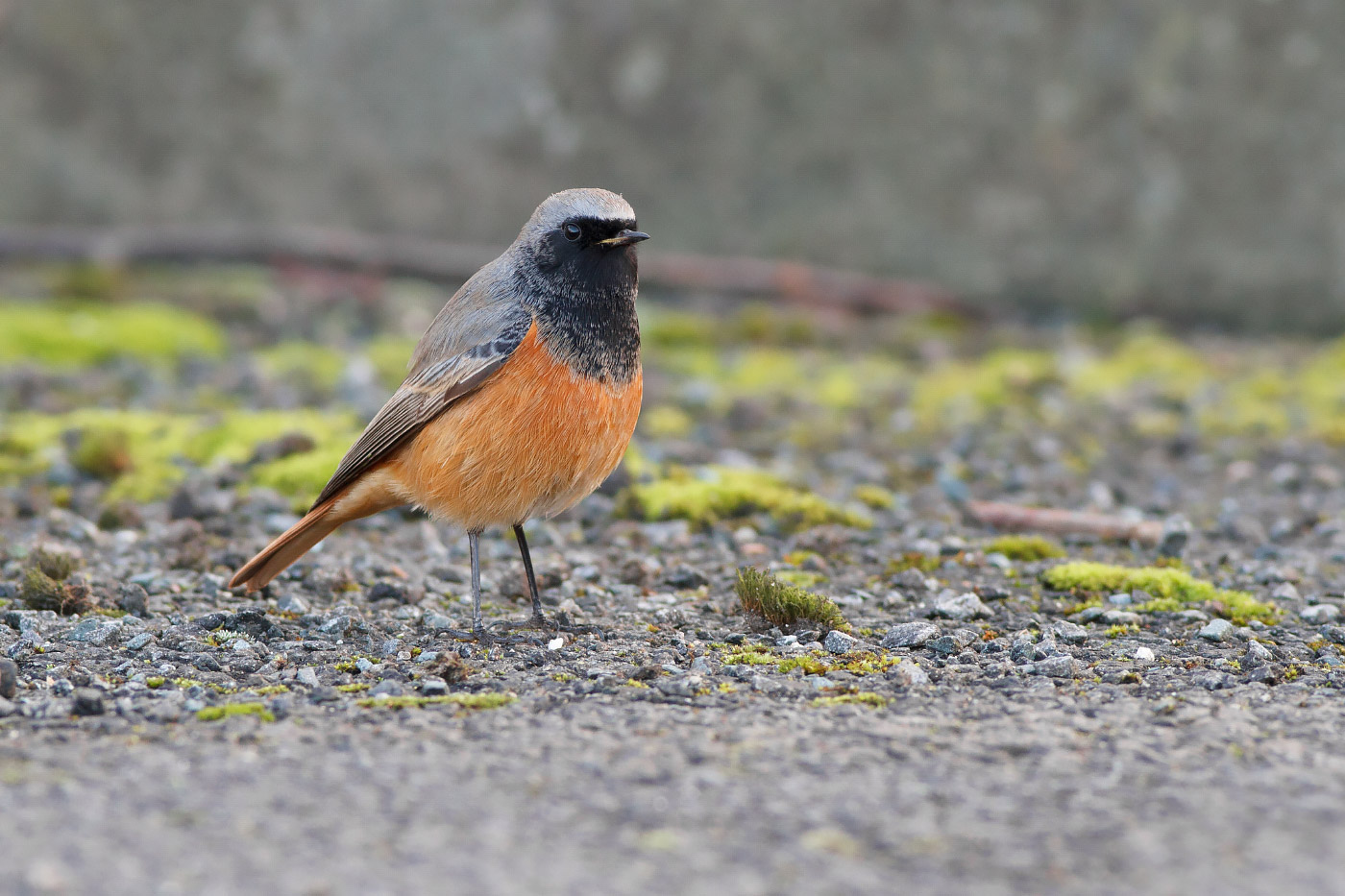
'Eastern Black Redstart' is a rare vagrant to western Europe. Males, like the above photographed in North Yorkshire in December 2014, are superficially similar to Common Redstart in appearance (Josh Jones).
Flexitarian
The species' diet is catholic and seasonally variable, but revolves around small- to medium-sized invertebrates, berries and fruit which is mostly taken on the ground, à la European Robin. As befits a member of the Muscicapidae, it also flycatches from low branches and walls and can hover in front of rocks and walls to pick off choice morsels.
Its moving feast will include everything from ants, aphids and grasshoppers to earthworms, bees and cockroaches, while for dessert, it will take blackberries, elderberries, cherries and honeysuckle, sometimes washed down with nectar. In spring, ants make up the lion's share of the diet; in autumn elderberries dominate.
To avoid ecological competition in areas where Black and Common Redstarts live very close to each other (such as in Central European villages), Black breeds an average of 19 days earlier than Common and specialises in caterpillars, spiders, woodlice and ant larvae, while Common concentrates on adult insects and beetle larvae. This ecological difference is also largely maintained in habitats where the two species don't overlap.
In winter, Black Redstart is usually solitary, though it can occur in pairs or small groups of up to five or six at sites with richer sources of food. Come the breeding season, it pairs off and becomes territorial, though nests can be as close as 5 m to each other. The male advertises its desires by singing from often very high songposts – a pair I once observed regularly near East India Dock in East London nested in the ceiling of a ground-level car park, but the male would sing from nearby rooftops at least 11 storeys high.
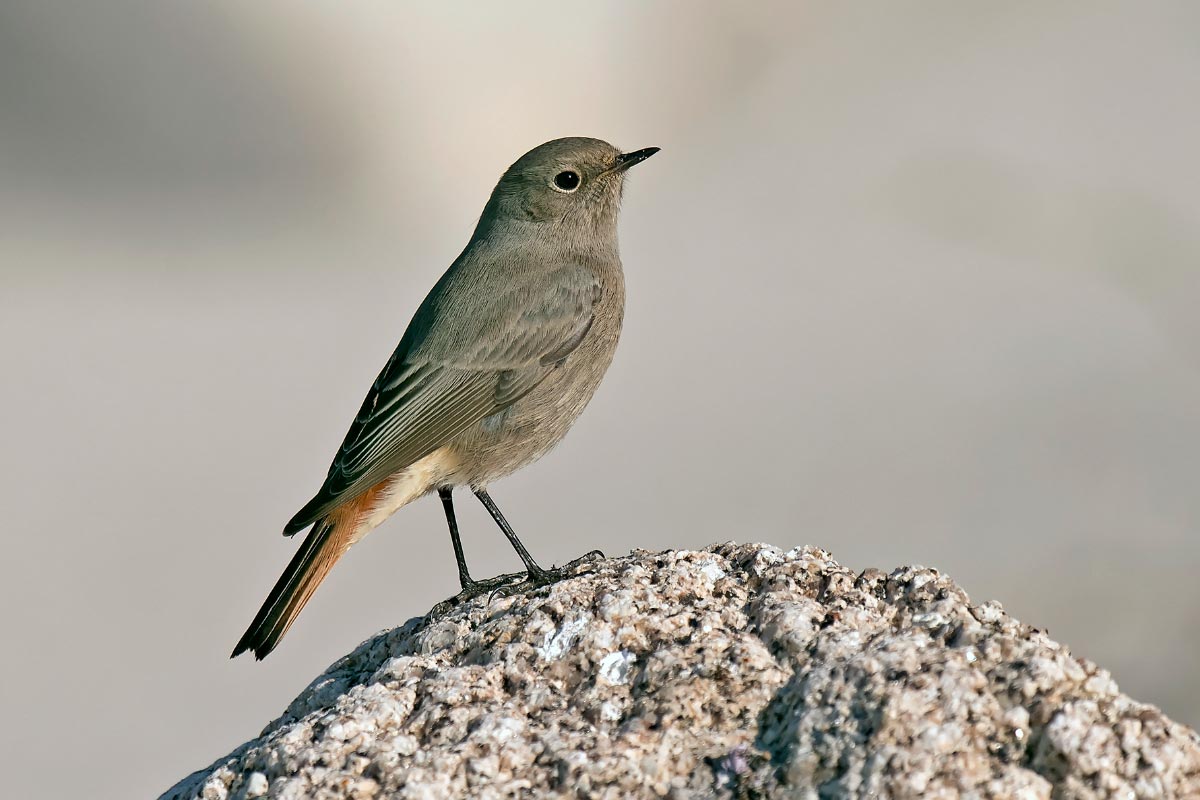
The species is most numerous on passage in Britain. This female was on St Mary’s, Scilly, in October 2016 (Steve Young).
Black Redstart is a monogamous species and can have up to three broods each season, a production rate perhaps enabled by its recent adaptation to urban breeding. However, a proportion of males stray to fertilise neighbouring females when they're not (somewhat hypocritically) guarding their 'main squeeze' from the attentions of other males – this behaviour is particularly frequent when multiple broods occur and there is more opportunity.
Courtship involves males chasing females relentlessly, interspersed with landing directly in front of their intended and 'dancing' by twisting from side to side. The female will eventually show her receptivity by holding her head up, drooping her wings, fanning her tail a little and ruffling her feathers, which will induce a heated shivering of the wings in the male immediately before copulation.
Home maker
The nest is usually constructed solely by the female in a crack or crevice in a rockface or wall from dry grass and leaves, lined with hair, wool and feathers. Into this are laid between four and six lightly spotted white or pale blue eggs, which hatch after being incubated by the female alone for about two weeks.
Once the young are hatched, the male remembers his duties and both parents feed the chicks for about two and a half weeks, before the fledglings make their first forays from the nest. They return to the nest to roost for up to 10 days afterwards, and a family group may forage and flock together for a month beyond that. As the species has been recorded living for more than 10 years, a healthy adult pair can produce about 50 young, taking into account that birds can breed in their first full year, even when they still possess the brown wings of immaturity.
Extra female-like birds have occasionally been recorded helping the main couple feed their offspring, but it has not yet been definitively recorded whether the co-operative bird was an adult female or immature male. When a habitat is rich in resources, first-year males arrive simultaneously on the breeding sites with mature adults and, while first years are known to breed, it may also be the case that they help out with the broods of full adults. However, in suboptimal habitats, the immatures arrive about three days later than adults, thus enabling the former to stake out the prime nest sites.
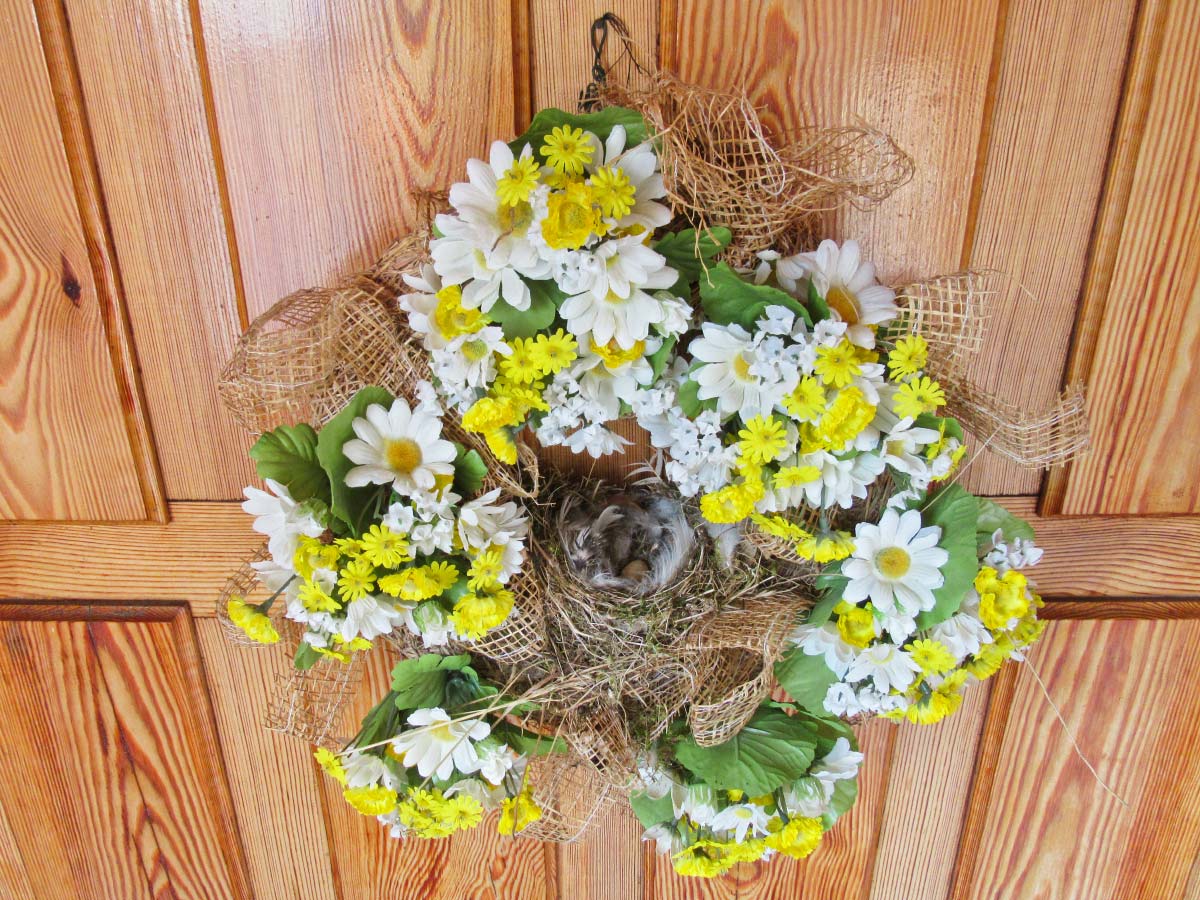
The species routinely nests close to or in human habitations, and will even exploit wreaths hung on doors in which to build its nest (Martin Grimm / BIA).
Decline and fall
There has been a notable decline in Britain's Black Redstart population, with its conservation status being upgraded from Amber to Red. This is likely to be linked to the gradual disappearance of abandoned and wrecked buildings. Black Redstart found the post-war construction boom to its advantage, but this meant that its territories were often ephemeral.
Gentrification and redevelopment are its enemy, often ridding towns of foraging places, if not their cliff-like buildings. The Birmingham area was one of the key breeding locations in Britain until this century, but the last survey of the West Midlands in 2016 found no breeding pairs, while there has been a similar nose-dive in Sheffield, Nottingham and Ipswich.
It is possible that climate change might mitigate for this in a small way, enabling sparse survival in a country with an incrementally more temperate environment. Recent conservation work has seen the provision of green roofs in cities as an encouragement for Black Redstart to remain in established locations, but there has been little conclusive research on whether this has worked.
There has been some debate as to why Black Redstart maintains such a fragile toehold in Britain, but it seems that our subspecies of European Robin may have filled some of the appropriate ecological niches which it is otherwise kept out of by competition with greater numbers of Black Redstarts on the Continent. However, the species retains its tentative British presence and, if you're not in one of the breeding areas, you stand a good chance of seeing a passage bird on the coast or even on an inland local patch.
In autumn and winter, the species is reported more widely and congregates in the West Country and on the south and east coasts, so keep an eye on BirdGuides.com for the latest sightings. They are likely to stay put in the coldest months, so why not pop in for a chat.
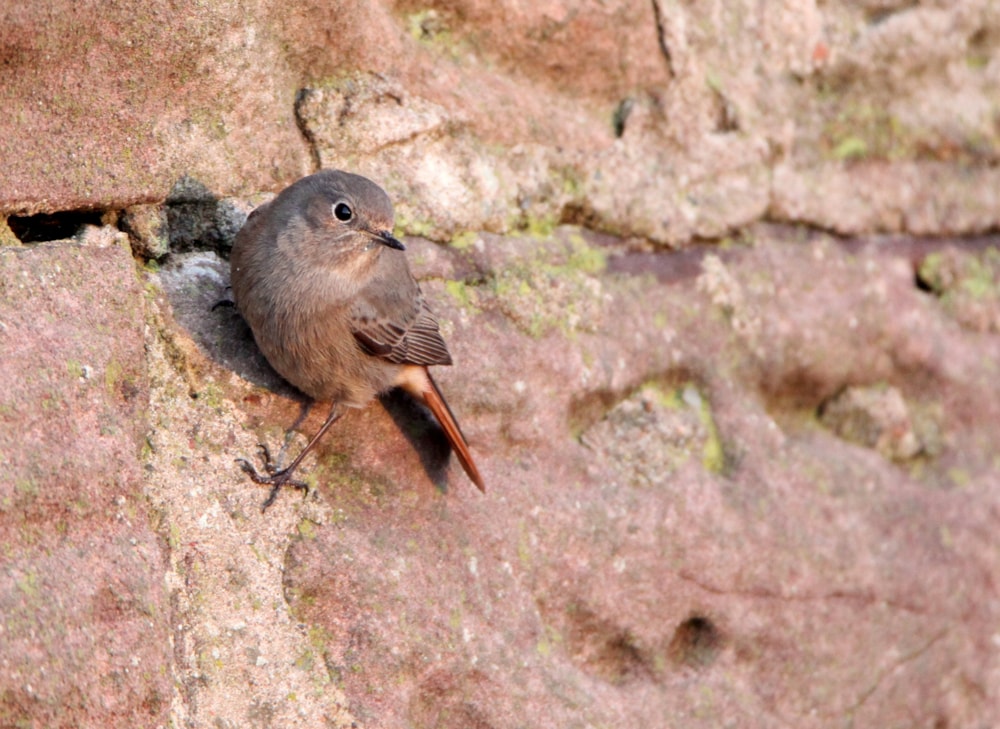
Though never numerous, Black Redstart winters widely across coastal Britain, particularly in the West Country and along the south and east coasts (Gus Guthrie).
References
Chen, J-N, Liu, N F, Yan, C, and An, B. 2011. Plasticity in nest site selection of Black Redstart (Phoenicurus ochruros): a response to human disturbance. Journal of Ornithology 152: 603-608.
Clement, P, and Rose, C. 2015. Robins and Chats. Christopher Helm, London.
datazone.birdlife.org/species/factsheet/black-redstart-phoenicurus-ochruros
Ertan, K T. 2006. The evolutionary history of Eurasian redstarts, Phoenicurus. Acta Zoologica Sinica 52 (supplement): 310-313.
Holloway, S J, and Glue, D E. 1999. Site Action Plan for Black Redstarts Phoenicurus ochruros in the Deptford Creek Area, Greenwich, London (BTO Research Report No 212). BTO, Thetford.
Leniowski, K, Wegrzyn, E, and Szczepanik P. 2013. A case of cooperative breeding in the Black Redstart Phoenicurus ochruros – labor division and a pattern of food distribution among nestlings. Avian Ecology and Behaviour 23: 41-49.
Lu, X, Ke, D, Guo, Y, Tang, S, Zhang, L, and Wang, C. 2011. Breeding ecology of the Black Redstart Phoenicurus ochruros at a Tibetan site, with special reference to cooperative breeding. Ardea 99: 235-240.
Petersson, A, Bergner, A, and Thorin, M. 2014. A hybrid Common Redstart x Black Redstart (Phoenicurus phoenicurus x P ochruros) breeding in southeastern Sweden. Ornis Svecica 24: 35-40.
Slack, R. 2009. Rare Birds: Where and When. Rare Birds Books, York.
Schwarzová, L, Štros, P, Frynta, D, and Fuchs, R. Arrival timing in subadult and adult Black Redstart males: competition-dependent behaviour? Ethology, Ecology and Evolution 22: 111-118.
Snow, D W, and Perrins, C M. 1998. The Birds of the Western Palearctic (concise edition). Volume 2: passerines. Oxford University Press, Oxford.
Stoddart, A. 2016. 'Eastern Black Redstart' – new to Britain. British Birds 109: 211-219.
Van der Spek, V, and Martinez, M. 2018. Identification and temporal distribution of hybrid redstarts and Eastern Black Redstart in Europe. Dutch Birding 40: 141-151.
Weggler, W. 2000. Reproductive consequences of autumnal singing in Black Redstarts (Phoenicurus ochruros). The Auk 117: 65-73.
Winsper, J, and Davies, S. 2017. Joint West Midland Bird Club and Regional BTO 2016/17 Regional Black Redstart Survey. West Midland Bird Club, Birmingham.
www.bbrc.org.uk/subspecies-information/waxwings-to-buntings
www.birdguides.com/articles/identification/common-and-black-redstarts
www.blackredstarts.org.uk
www.hbw.com/species/black-redstart-phoenicurus-ochruros




